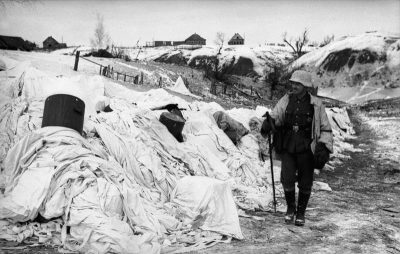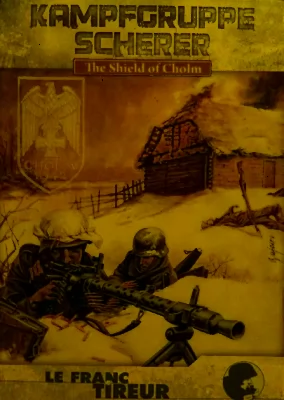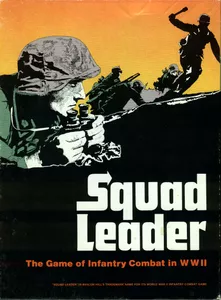Interview with an Advanced Squad Leader scenario designer
 By David Garvin
By David Garvin
One of the many reasons I play Advanced Squad Leader (ASL) is because I am a self-professed amateur historian. The history of the Second World War is not only fascinating but is rich and has even to this day many surprises awaiting anyone who wants to dig deep enough. I intend to do a blog post on how ASL is part history teacher.
For example, it is through ASL that I learned of a battle in early 1942 to the west of Moscow, The Battle of the Kholm Pocket. I discovered this epic battle through the purchase of a Historical ASL (HASL) product from a 3rd party producer, le franc tireur. Based in France, this HASL was designed by Andrew Hershey of Virginia. Before doing a blog post about learning history through gaming, I reached out to him and interviewed him. That interview follows now.

ASL came out in 1985. It was preceded by the Squad Leader series. Did you start with ASL or were you a Squad Leader (SL) Player before that?
I started with the “orange” box Squad Leader in 1978. I was in high school. I then proceeded through all the SL expansion modules from there. When Avalon Hill announced that “Advanced” Squad Leader would come out, I was pissed, having spent all my hard-gained money on SL, Cross of Iron (COI), Crescendo of Doom (COD) and GI: Anvil of Victory, so pissed that I boycotted ASL altogether.
A boycott that was made easier by the fact that by 1986 I was in graduate school getting my M.A. and I did not have the time to play in any case.
This hiatus from SL and ASL lasted until the fall of 1988, when now working on my Ph.D. In London, I found myself needing something to take my mind off my graduate studies. My then-wife was traveling back to the U.S. for a conference, and I asked her to bring back the ASL Rule Book (ASLRB) and Beyond Valor (BV), which she did. I unwrapped the ASLRB from its shrink slid the book out of its casing and randomly opened it to fall on the section about machine guns and rate of fire, fire lanes…and so ended the boycott and Squad Leader sailed into the past…and my ASL journey was underway and I have never looked back.

The scenarios of ASL are mostly based on real battles of the 2nd World War. How important is it to you that the scenarios are based on actual events?
Paramount. I have no interest in “Operation Sealion” style scenarios, and I would not buy such a product. I do not do Design your Own (DYO) scenarios either, in the sense of the Chapter H format. I do of course design scenarios, but always linked to real battles, and most preferably linked to real terrain, as in HASLs.
Your name is on at least 93 scenarios, according to the ASL Scenario Archive. Do you remember the first scenario you designed? What inspired you to design that first scenario?
I was unaware of the exact figure [of 93]. Yes, I recall the first scenario I designed, it was “A View From the Top.” Scenario G13, which accompanied my article on The 10th Mountain Division which appeared in “The General” for May of 1992. At that time scenarios went uncredited. The actual design date would have been 1990-91. At the same time as I did “View,” I also did “The Last Drive,” also about the 10th Mountain, but that scenario did not see the light of day until 2018 as FT251.
I was inspired to write the article on the 10th Mountain Division and design scenarios about them because from May 1987 – June 1988 I worked construction jobs in the Vail Valley. On my weekends off, I would hike near where old Camp Hale was located, this is where the 10th Mountain Division trained during WW2. You could come across old bivouac sites and c-ration cans every now and then.
I also have another connection to the 10th in that I did my M.A. at the University of New Hampshire, and several of its officers graduated from UNH….and of course, it was the men of the 10th who would go on to found Vail Ski resorts, and develop the ski industry in the USA after WW2…and not just in Vail.
Cholm. This name is not well known in the West or even among us amateur historians who read all we can about the 2nd World War. When did you first hear of Cholm?
After I did Special Forces I, for Heat of Battle, which was a historical study type pack on the Special Air Service and Long Range Desert Group in North Africa and in Europe I went looking for another “special forces” type action. In fishing about, I broke out my copy of “Combat Aircraft of World War Two,” which I got for Christmas in 1978 from my dad.
Besides beautiful color plates, the book is data packed, and in the age before wiki, it effectively held all the stats and brief blurbs on all combat and non-combat aircraft of WW2. I decided to look up the DFS230 German glider, having known of their role in the air assault on Eben Emael, and of course Crete.
There I came across this brief line “well-known missions [ie ed. the above actions]… but equally exacting supply/relief missions both in the Mediterranean theatre and, more importantly, on the Eastern Front; latter commenced with supplying the Cholm pocket Jan-May 1942…” And brief line is what landed me in Cholm, and that would have been in 2007.
I believe that I gain a better understanding of various battles by gaming scenarios and especially HASLs. Would you agree? Can you perhaps explain why this is?
Yes, I agree that through HASL that one gains a better understanding of a particular battle. I think this is:
a) because one is now gaming “battle” on terrain that is very close to the actual terrain of the battle itself versus the more generic terrain of a “geomorphic” scenario, and so the decisions of the commander and the tactics used are better understood through more accurate terrain….
b) designers of HASLs are tapping into more resources that a conventional “geomorphic” scenario design does, which is often constructed from just one source and within that maybe only two pages or less. Whereas, take Tom Morin’s masterful “Valor of the Guards,” he had access to Soviet-era archival materials as well as German ones, this enabled him to impart great detail.
This is shown not only in the map, and through the intros and aftermaths to scenarios, but likewise by set up instructions (he knows in good detail where certain weapons were located, that is why you the player are not free to put them wherever you want) or in Scenario Special Rules (SSR), which impart additional details.
Some would say that ASL is in a golden age, with so many new products being published by MMP as well as by 3rd parties. Would you agree? If so, why do you think that is?
Yes, I think we are in a golden age. I would go so far as to suggest that we are even in a second such gilded age, as certainly back in the late 80s and early 90s, ASL rolled off the production line at a good strike rate, between modules, articles, and scenarios in “The General” and then the advent of the ASL “Annual,” the birth of ASLOK and mini-tournament scene.
But, as to why are we in this golden glow at all, that is down I think a testament to the game itself. There is no other WW2 tactical war game in my book…whether in cardboard form or bits and bytes. In addition, this golden glow is also imparted by each of us in the ASL community, and a community we are.
We not only share the game, and foster newbs along the road to tactical viability in the game, but we know about each other and care about each other, and mourn the loss of those who have passed on. An example of this is when Paul M. Weir passed away. He for those of you who may not know was an Irish ASLer, but played the game mostly solo, but he was an ASL community leader and giant though his presence on Game Squad. Where his knowledge of WW2 vehicles, aircraft, and weapons was second to none, and he was a source many designers, including myself, often consulted with.
Furthermore, he was always a gentleman in a media form in which our animal instincts often rear their ugly head. But in short, the golden age is created by the game itself and the ASL community.
Finally, suppose a novice gamer who maybe has read about some interesting battle and would like to design a scenario based on it. What kind of advice would you offer him?
Try to find more than 1 source about your battle. Try to find out as much about the terrain as you can, and do not be afraid to use overlays to achieve your battle-scape. Should you be lucky to have 3-4 sources and excellent details, perhaps say about the number of machine guns on each side, be wary of this- exact orders of battle do not universally translate into ASL game design. Why?
This is in part to do with 2d6 and the bell curve, and more so to the fact of omnipresent player control of their pieces. Finally, you will need to find playtesters (another feature of the ASL community, and likely the most important ones in it) who will give up their valuable time to test your design. Treat them well, and listen to their feedback, some of which you won’t like to hear, but will need to take on board to make your scenario a runner.
David Garvin is an aspiring ASL game designer and amateur historian, and Dr. Andrew H. Hershey holds a Ph.D. in Medieval History from King’s College, University of London, and was, in 2005, elected a Fellow of the Royal Historical Society. For over 30 years he has been and remains to this day, a contributing member of the ASL community in many roles. He is a playtest coordinator, proofreader, scenario designer, module designer, and ASL mentor to many. But, by his very own admitted intellectual shortcomings, Andy remains VASL-illiterate to this day. A loss-loss all around. [Ed. His ASL Game pieces have also been around in excess of 30 years. And it shows!]

So much time, effort and knowledge goes into making these games real life scenarios. Makes me happy to see so much passion from not only the designers but the people that play.
Thank you. Dr Hershey is a fine example of the type of people producing the scenarios and other products in ASL. There is a lot of work that goes on behind the scenes and there is definitely pride in the work involved.
Great interview, thanks! A small typo here, “few” for “view”: Yes, I recall the first scenario I designed, it was “A *Few* From the Top.” Scenario G13,”
Thanks for catching “Few”
Thanks, Paul! I thought he said “few”. Might need my ears checked 😉
Don’t leave out Operation Merkur from Heat of Battle, which Andrew had a big hand in.
Personally, one of my favorite modules.
Hi Mark
Thank you for that. Andrew is a humble and prolific designer. He has had his hand in many ASL products for producers from Avalon Hill and MMP to 3rd Party Producers such as HoB and lft. His stuff is all top notch!
The quality of his scenarios should demonstrate that Andy is a great researcher. Was pleased to interact with him during the design of Forgotten War, and I believe the Modern ASL group that Frank Meier had been running on Yahoo years ago. Andy would be a great project manager as he has a gift for coordination, communication and organization. Nice to see his work given some recognition here. I get the feeling scenario and campaign design is often a lone-wolf activity but Andy has always gone the extra mile of tracking down arcane details in order to get them right.
Hi Michael
I concur with all that you say. I’ve met Andy on several occasions and have had the pleasure of playing him. He never plays his own designs. I cannot blame him, though it would be nice to play the designer just as that next-level experience.
There will be follow-on posts about his work, specifically “Shield of Cholm”. This post is just to show just how much brain power goes into this game of ours.